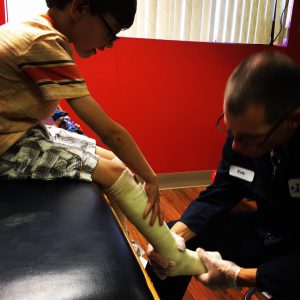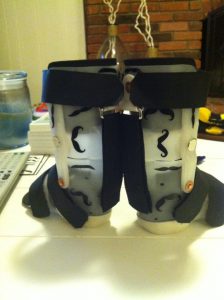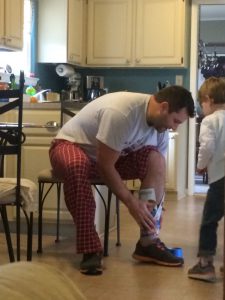
For some of our HIE children, some type of orthotic (sometimes called a brace) may be necessary to help with development, ambulating and balance. There are a few different types of orthotics that may be considered. For some children, simply a shoe insert might be a good tool. For others, a solid or articulated (hinged) Ankle-Foot orthosis (AFO), or a short Supra-Malleolar Orthosis (SMO) might work best.
Some children may need an orthotic for just one side or foot, as is common with hemiplegic cerebral palsy, others for both, either due to balance issues, or because of another type of cerebral palsy.
Most people will be referred to an orthotist by one of their medical team members – sometimes it’s a pediatrician, a physical therapist, a neurologist or a physiatrist/physical medicine and rehabilitation doctor.
Once referred, you’ll meet with the orthotist to determine the best type of orthotic for your child.

For the tall AFOs or short SMOs, typically a child will be casted for a custom fit. Many families may be curious of what the casting process is like.
At the casting appointment, the orthotist will place a cloth sock on your child’s legs and feet. They will wear rubber gloves, so the casting supplies don’t stick to the child, or to the orthotist. They will place a long rubber piece with a groove in the middle so your child is protected and it’s easy to cut off the cast once it has set.
They will then dip the casting supplies into warm water and wrap the cast material around your child’s leg and feet. They may make some marks on the casts of where your child’s bones are with a permanent marker.
Once the cast has set, the orthotist will either use scissors or a utility knife to cut the cast off. This process is not painful and very quick!
Typically, it’s a 4-6 week process for the orthotist to turn around the custom orthotics back to you for a fitting.

Some places will have a selection of transfer patterns to decorate the orthotics. My own son has an affinity for superheroes, so he has had everything from Superman to Spiderman.
If you want to do something on your own, I’ve had good luck with vinyl stickers from Etsy. My son’s first AFOs were decorated with mustaches.
The more fun you make it, the more fun your child will have. There’s also a fun transfer pattern tool here.

As a parent, sometimes it can be hard to see something else that makes your child “different”. However, it’s also an opportunity to help your child reach whatever their potential may be and is just another tool to do so.
I have seen Max’s orthotics help him pull to stand, gain balance and confidence, walk with a gait trainer, then a walker, and now independently. He pumps on swings. He climbs playsets. Without his orthotics, he wouldn’t be able to do these things.
My husband has also been called upon to “make a brace” for himself. And the more we normalize it, the more Max is confident with it helping him.
We’ve also had great luck with educating others and having our school team teach Max’s teachers how to take them off and put them on.
Tall socks tend to be easier to find for girls. Infant and Toddler socks are harder to find, but we’ve had immense luck with a company called JuDanzy. They make tube socks! Old Navy also carries triple fold socks that work well. And, as kids grow bigger, soccer socks are an option.
More and more shoe options are becoming available for fitting over braces. Here are some things to look out for and some links to companies that provide shoes that are great for AFOs and SMOs. Ability Hacker also has a great section on fitting shoes over AFOs.
Connect with families, read inspiring stories, and get helpful resources delivered right to your inbox.